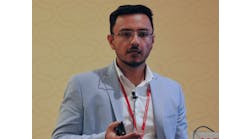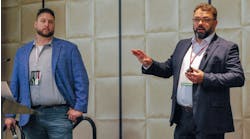It takes some quick paddling to ride the crest of the incoming digitalization and artificial intelligence (AI) waves, but that’s exactly what Honeywell’s innovators and experts did during the opening keynote session of the 2024 Honeywell Users Group this week in Dallas. Led by Industrial Automation CTO Jason Urso, the Honeywell Process Solutions team showed how automation is digitalizing to take in data from 10 times more sensors, develop digital lifecycle twins and achieve higher operational availability with less equipment via mobile handhelds and digitalized services.
“Automation is evolving to deliver new benefits, maximize throughout and yield, automate efficiency and maintenance scheduling, and assist and guide performance to an elite level, so every day can be the best day of production,” said Urso. “This is why automation is evolving towards more digitalization, adopting 5G wireless, and benefiting from more plentiful computing, so users can turn data into action by seeing what couldn’t see before. We call this Digital Cognition.”
Urso reported that Honeywell’s Digital Cognition initiative includes minimizing risk, integrating AI with analytics, reducing manual tasks and typical communications times, and extending lifecycle services for operational longevity—all while delivering unprecedented efficiency. This awareness level also includes monitoring each piece of equipment, so users can address issues before they impact production. From this perspective, even distributed control systems (DCSs) are becoming Digital Cognition systems. However, this makes it even more important to protect them with Honeywell’s Cyber Insights security initiative. One of the primary cornerstones of Digital Cognition is how it’s driving the evolution of the Honeywell Experion Process Knowledge System’s (PKS) Highly Integrated Virtual Environment (HIVE), how this longtime, well-established control system is applied to new and capital projects, and how it can speed up project planning while also reducing risk.
“Where controls were previously sequential and layered, Digital Cognition makes Experion HIVE modular and parallel, so it can be deployed across multiple module yards, implemented in production with less cabling and other equipment, and even self-assemble components that can connect with any I/O,” explained Urso. “Digital Cognition is what allows these devices and control functions to find each other, and assemble into a self-joining, elastic computing cluster, which is more like an IT-style data center.”
Cogs in the HIVE
For instance, to enable startups and benefit existing applications, Honeywell’s Projects and Execution CTO Brian Reynolds reported that Experion R530 was released in February and has already been deployed along with HIVE technology by several end-users, who are achieving real-world results.
“HIVE is needed because many users are soon going to have 10 times as many sensors measuring everything from acoustics to video to vibration, and they won’t be limited by traditional constraints,” said Reynolds. “Likewise, our IO Hive products will maintain their traditional capabilities, but add Ethernet Advanced Physical Layer (APL) protocol and wireless networking, too. This will enable more resilient systems with real-time sensor modeling, soft-sensing and faulty-sensor substitution, as well as compute-intensive analytics and AI for dramatically improved control performance and entirely new capabilities.”
Likewise, Reynolds added that Honeywell’s resilient, secure and scalable Control HIVE solution will be further enabled by the recently developed Module Type Package (MTP) protocol, which includes a process orchestration layer (POL), configuration files and process equipment assembly (PEA). MTP is expected to streamline manufacturer-independent connectivity, standardize data-transfer configurations, and save development time. “MTP’s POL can run on HIVE for performance, availability and scalability,” said Reynolds. “It will be available soon as part of an R530 update.”
Experienced eyes—and veteran advice
Once it becomes fully established, Digital Cognition is also expected to demonstrate increasing autonomy and become adept at showing users what they couldn’t see before. “Similar to a driverless car with added sensors and analytics, which enhances human abilities by alerting them to hazards, Digital Cognition can serve as a copilot and expert assistant,” explained Urso. “An elite operator or engineering expert with 30 years of experience has seen events like an unusual bearing failure before and can show a coworker with only two years of experience how to solve it. We expect Digital Cognition to let the two-year staffer perform like the 30-year staffer.”
To help rookies work like veterans, Digital Cognition is also shifting Experion’s user experience (UX) to an even more interactive experience (IX), according to Rohan McAdam, senior fellow at Honeywell. It will accomplish this by:
- Automatically presenting information to operators,
- Providing semi-automated and automated assistance,
- Automatically capturing data for record-keeping,
- Directing users’ attention to tasks they need to worry about,
- Deal with potential process issues, and
- Provide users with sound guidance.
For example, Honeywell’s Highly Augmented Look Ahead (HALO) software lets users be more attentive to their processes by delivering a unified interface the provides situational awareness about items like extreme weather events or potential compressor trips, conducts situational investigations, and generates typical responses and other guidance. These functions are aided by Honeywell’s AI-based Generative HMI (human-machine interface), which enables its situation guidance, key metrics, status indicators and other parameters, and will soon be able to integrate video, animations and other rich content.
“Instead of individual alarms, Generative HMI presents users with situations and effective responses,” explained Graeme Laycock, UX design director at Honeywell. “All the content that used to be on multiple screens is now available and summarized in one view. Next, Generative HMI can employ AI agents to validate the insights and guidance they’re receiving. This is just like an expert assistant for someone driving a car, but now it’s advising on a process application’s feed rates and energy use. This will be rolled out later this year as Experion Operations Assistant.”
Apps for batches
To achieve similar gains in batch operations, Digital Cognition is contributing to Honeywell’s Application HIVE (App HIVE) manufacturing platform, which combines its Manufacturing Excellence Platform (MXP) for manufacturing execution systems (MES), batch historian and HMI capabilities for performing tasks like overall equipment effectiveness (OEE). However, App HIVE doesn’t stop there because it’s also added and updated new functional modules, reduced required validation efforts and eliminated many former system migration chores. It consists of:
- Installed apps such as those for production insights, operator dashboard, shift planning, digitalized work instructions and electronic batch records; and
- Available apps such as OEE, equipment maintenance, digitalized add-ons, weigh and dispense, formula sets, recipe management, electronic logbook and MTP.
“Users can install, click through and upgrade these apps, as well as customize them and create sublocations that contain everything the need, or they run them independently as needed,” said Alicia Kempf, offering management director at Honeywell. “This also gives them a sandbox, where they can experiment with container management and advanced analytics.”
Peter Davis, senior engineering director at Honeywell, reported that MXP is also cooperating with Honeywell’s Sparta Systems and TrackWise Digital, which joined last year to natively integrate data from third-party DCS and batch systems without requiring reengineering. “Together, they can reduce variability and drive optimization in unit and plant operations by identifying root causes, and directing users to recommended actions,” added Davis. “This kind of AI can enable predictive analytics for closed-loop processes.”
Assets and safety in the field
Similarly, Urso demonstrated how Digital Cognition can enhance holistic asset views, performance management and reliability by developing digital twins of process and energy applications. For instance, after recently acquiring Compressor Controls Corp. (CCC), Honeywell took its mapping and trending software a step further, so it can work with Digital Cognition to digitally enable surge suppression functions. In fact, the company’s production intelligence initiative has resulted in its Honeywell Forge Performance+ solution, which was built on its partnership with Microsoft. This software:
- Generates maintenance job packs with workorder insights,
- Answers queries about equipment, and
- Automatically detects duplicate field observations.
“Forge Performance+ works like the brain works, so users in their morning meetings already have the top five issues they’ll likely need to deal with today,” said Urso.
To put more digitalized and AI tools in the hands of field personnel, Honeywell also introduced its Field Process Knowledge System (PKS). Instead of relying on the traditional walkie-talkie, Ramesh Babu Koniki, fellow at Honeywell, showed how its Field Assistant AI software generates probable causes and recommendations. It provides steps for implementing and maintaining transmitters, and lets users upload photos and documentation for their news transmitters.
On the safety front, Andrew Brodie, senior director of offering management at Honeywell, showed how Koniki’s wearable gas detector was part of its safety suite of products. These items include its user-friendly BW Rigrat wireless gas monitor and Honeywell’s Managed Safety as a Service, which digitalizes enterprise worker safety with real-time locations, trails and history, evacuation routes and crowd-sourced analytics functions. To make residential utilities safer, Urso added that Honeywell is also releasing its AC 250 NXU ultrasonic gas meter, which can detect leaks and remotely close valves via a cellular connection to help prevent accidents.
Sustainability and security
To provide power when the sun isn’t shining and the wind isn’t blowing, Honeywell Ionic battery-based energy storage and control system debuted last year. It allows full-service, remote operations, and can be monitored via Experion, too. “Honeywell Ionic has preconfigured controls and can add other Honeywell services,” said Paul Vellacott, senior offering manager at Honeywell. “Some users have reported saving $10 million per year by avoiding price spikes on their local grids. They can also conserve or avoid replacing spinning reserve assets because they no longer have to keep them running all the time.”
To keep all these assets and processes secure, Urso added that Honeywell’s Cyber Insights solutions:
- Constantly monitor assets,
- Identify vulnerabilities, and
- Point out threats indicative of malware.
“However, users also want to know if they’re complying with cybersecurity standards, so our Cyber Watch monitors and confirms compliance with IEC/ISA 62443, EU-based Network and Information Security (NIS) 2, and NERC-CIP standards, as well as Honeywell’s Custom Compliance Framework.
“Cyber Insights quickly identifies assets, and determines whether they’re achieving cybersecurity compliance,” added Urso.








